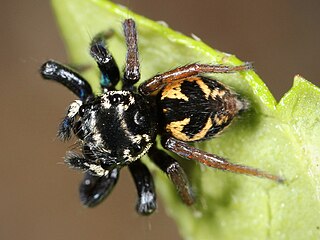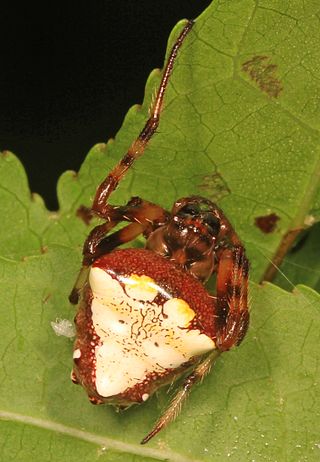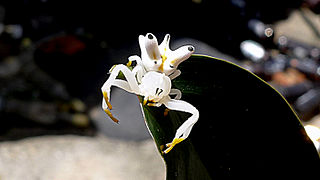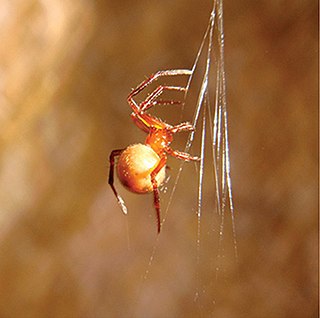
Theridiosomatidae, commonly known as Ray Spiders, are a family of araneomorph spiders first described by Eugène Simon in 1881. The family includes 137 species divided between 20 genera. They are most recognizable for their construction of cone-shaped webs.

Theridiosoma is a genus of ray spiders that was first described by Octavius Pickard-Cambridge in 1879. They use their web as a high speed slingshot to actively hunt for prey.

Corythalia is a genus of jumping spiders that was first described by Carl Ludwig Koch in 1850. The genus is distributed throughout most of the Western Hemisphere. Species of this genus are found in The Americas.

Pachomius is a genus of jumping spiders that was first described by George and Elizabeth Peckham in 1896. Uspachia was merged into genus Romitia in 2007, and all nine species were merged into Pachomius in 2015. The name is derived from Pachomius, the founder of cenobitic monasticism.
Mysmenopsis is a kleptoparasitic genus of tiny tropical and subtropical American spiders in the family Mysmenidae. Most live in the funnelwebs of spiders in the family Dipluridae. M. archeri lives on webs of a species in the family Pholcidae, M. capac and M. cienaga have been observed living in Cyrtophora (Araneidae) webs. One reason why diplurid webs are preferred seems to be that they are persistent in time and space, sometimes spanning several years.

Bertrana is a genus of Central and South American orb-weaver spiders first described by Eugen von Keyserling in 1884. It includes some of the smallest known araneid orb-weavers. Bertrana striolata females are 4.5 mm long or less. The eight eyes are in two rows. The abdomen is white on top and on the sides, with multiple hieroglyphic-like lines and bars of many different shapes and length. In females, these are red, in males, black.
Masteria is a genus of curtain web spiders that was first described by L. Koch in 1873. They occur in the tropics of Central to South America, Asia and Micronesia, with one species found in Australia. M. petrunkevitchi males are 4 millimetres (0.16 in) long and females are 5 millimetres (0.20 in) long. M. lewisi, M. barona, and M. downeyi are slightly smaller and have only six eyes.

Cryptachaea is a genus of spiders in the Theridiidae family.

Linothele is a genus of curtain web spiders that was first described by Ferdinand Karsch in 1879. All but one of the described species are from South America. The exception is L. septentrionalis from the far-away Bahamas, although it has certain features that suggest it may belong in another genus. Additionally, an undescribed species of Linothele is known from Panama.
Anapis is a genus of araneomorph spiders in the family Anapidae, which consists of small orb weaving spiders all from the Neotropical realm. The genus includes close to thirty species and was first described by Eugène Simon in 1895.

Verrucosa is a genus of orb-weaver spiders first described by Henry McCook in 1888. It contains almost fifty described species, most of which live in South America. The only species in the United States is the arrowhead spider.
Chthonos is a genus of South American ray spiders that was created by Jonathan A. Coddington in 1986 because the previous name was preoccupied. Originally placed with the Orb-weaver_spiders under the name Tecmessa, it was transferred to the ray spiders in 1986.

Ogulnius is a genus of ray spiders that was first described by Octavius Pickard-Cambridge in 1882.

Epicadus is a genus of crab spiders that was first described by Eugène Louis Simon in 1895. It is considered a senior synonym of Tobias.

Plato is a genus of ray spider. The American biologist Jonathan A. Coddington named and circumscribed the genus in 1986. It is a Neotropical genus and it is limited to South America. As of 2018, nine species are recognized. They are found in caves and have a distinctive cubic egg sac. The generic name comes from the ancient Greek philosopher Plato.

Baalzebub is a genus of ray spiders first described by Jonathan A. Coddington in 1986. Spiders in this genus typically live in dark environments, like caves.
Cinetomorpha is a genus of goblin spiders first described by Eugène Louis Simon in 1892. It is a senior synonym of Lucetia, and Yumates.












